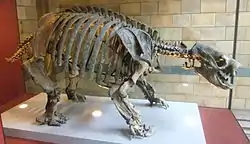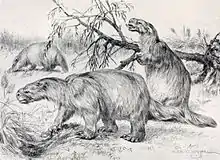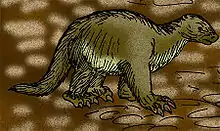Glossotherium
Glossotherium (literally "tongue beast") was a genus of ground sloth.[1] It was a heavily built animal with a length of about 4 metres (13 ft) snout to tail-tip, a weight estimated at 1,000 kg (2,200 lb),[2] and could potentially assume a slight bipedal stance.
| Glossotherium | |
|---|---|
 | |
| Skeleton in Natural History Museum, London | |
| Scientific classification | |
| Kingdom: | |
| Phylum: | |
| Class: | |
| Order: | |
| Family: | |
| Subfamily: | |
| Tribe: | †Glossotheriini |
| Genus: | Glossotherium Owen 1840 |
| Species | |
| |
| Synonyms | |
| |
Description

Sloths are grouped into three categories: mylodontids, megalonychids, and megatheriids. Glossotherium belongs to the Mylodontidae, in which it is further subcategorized into the Mylodontinae, characterized both by the loss of the entepicondylar foramen of the distal humerus and anteriorly broad snouts.[3]
Mylodontinae has five genera: Lestodon, Thinobadistes, Mylodon, Paramylodon, and Glossotherium. The latter three have frequently been confused for each other in scientific literature,[3] though it is likely Paramylodon and Glossotherium share a more recent common ancestor than with any other mylodontid.[4] Paramylodon is typically larger than Glossotherium, even though there is overlap in their size ranges, and Glossotherium is generally wider and more robust with a diagnostic increased amount of lateral flare at the predental spout.[4]
Glossotherium robustum was endemic to South America and weighed about 1500 kg.[5] Pleistocene records indicate that it was widely distributed between 20⁰S and 40⁰S, with a range spanning across Argentina, Brazil, Bolivia, Chile, Uruguay, and Paraguay.[6]
Dentition
Sloths have an ever-growing adult dentition. They lack deciduous dentition and have a reduction in tooth number. Sloth teeth also lack the enamel and cuspation pattern generally present in other mammals. Their tooth forms are oval, subrectangular, or elongate irregular ovoid with chisel-shaped “caniniform” teeth anteriorly and “molariform” cheek teeth. Glossotherium has a layer of cementum surrounding all molariform cheek teeth with some traces on caniniform teeth. Cheek teeth in Glossotherium are larger, have more complex shapes, and retain more of the cementum layer around all sides of each tooth than the Shasta ground sloth, Nothrotheriops shastensis, and tree sloths.[3]
Discovery

Fossils of this animal have been found in South America and Mexico.[7] It is closely related to Paramylodon of North America, whose specimens have often been confused with it and assigned to Glossotherium, which in turn was initially assigned to Mylodon. The earliest Glossotherium specimens are known from the Pliocene of South America and are represented by the species, G. chapadmalense. All specimens of Pleistocene age are typically lumped into G. robustum and a few other questionable species. Further research is needed at the species level.
Palaeobiology
Due to its size and strength, Glossotherium would have had few natural enemies apart from the South American short-faced bear Arctotherium and sabre-toothed cats such as Smilodon. It is believed to have died out in the Pleistocene (1.8 million - 12,000 years ago). The most recent reported date is about 8700 years BP.[8]
Diet

Details of Glossotherium’s diet are unclear since no dung deposits are available for analysis. However, based on dental evidence, Glossotherium was likely more suited to grazing, though it was also probably less efficient at ingesting grasses since its dental apparatus was more suited to shearing, which would have been too ineffective at processing plant materials down to an ingestible size to obtain adequate nutritive value. More recent tree sloths have a very slow rate of passage of food through the gut and it is likely that Glossotherium did as well. With a likely low metabolic rate, a large body size, a consequently reduced energy requirement for its weight, and an extraordinarily large gut that likely had a foregut fermentation site, Glossotherium could probably survive better on foods of lower nutritional value than other sloths could. Though it is likely Glossotherium primarily ate grasses, it also probably ate a variety of foliage as well and would be better considered a “browser-grazer” than simply a grazer.[3]
Hearing
Glossotherium had large ear ossicles, similar to those in elephants, which imply the loss of hearing acuity of higher frequencies, further implying an advantage for sensing low frequency sounds, infrasound, or bone-conducting seismic waves.[5] Low frequency sound is useful for long range communication and it is possible that ground sloths used low frequency communication in much the same way that it is utilized by elephants. Sloths may have used low frequency sounds for communication in mating calls or other social interactions, or for long-range sound sensing as in predator-prey interactions or weather forecasting.[5] Another possible explanation for hearing in low frequencies may be due to fossorial habits: low hearing frequencies coupled with a short interaural distance suggest that Glossotherium probably had very poor sound localization. This indicates evidence of an underground lifestyle since loss of high frequency hearing is common to fossorial mammals.[9] Glossotherium’s huge nostrils were likely effective for sound emission, with expanded nares possibly related to emission of low frequency sounds up to 600 Hz.[5]
Distribution
Fossils of Glossotherium have been found in:[10]
- Luján and Agua Blanca Formations, Argentina
- Charana and Tarija Formations, Bolivia
- Japones Cave, Lagoa Santa and Lage Grande, Brazil
- Santa Elena Peninsula, Ecuador
- General Bruguer/Riacho Negro, Paraguay
- Talara tar seeps, Peru
- Sopas Formation, Uruguay
- Taima-Taima, Venezuela
References
- McDonald, H. Gregory; Agenbroad, Larry D.; Haden, Carol Manganaro; Jones, Cheri A. (2004). "Late Pleistocene mylodont sloth Paramylodon harlani (Mammalia: Xenarthra) from Arizona". The Southwestern Naturalist. 49 (2): 229–238. doi:10.1894/0038-4909(2004)049<0229:LPMSPH>2.0.CO;2. JSTOR 3672689.
- http://sedici.unlp.edu.ar/handle/10915/16838?show=full (in spanish)
- Naples, V. (1989). "The feeding mechanism in the Pleistocene ground sloth, Glossotherium". Contributions in Science. 415: 1–23.
- McAfee, R. (2009). "Reassessment of the cranial characters of Glossotherium and Paramylodon (Mammalia: Xenarthra: Mylodontidae)". Zoological Journal of the Linnean Society. 155 (4): 885–903. doi:10.1111/j.1096-3642.2008.00468.x.
- Blanco, R. (2008). "Estimation of hearing capabilities of Pleistocene ground sloths (Mammalia, Xenarthra) from middle-ear anatomy". Journal of Vertebrate Paleontology. 28: 274–276. doi:10.1671/0272-4634(2008)28[274:eohcop]2.0.co;2.
- Pitana, V. (2013). "Cranial and dental studies of Glossotherium robustum (Owen, 1842) (Xenarthra: Pilosa: Mylodontidae) from the Pleistocene of southern Brazil". Alcheringa: An Australasian Journal of Palaeontology. 37 (2): 147–162. doi:10.1080/03115518.2012.717463.
- http://paleodb.org/cgi-bin/bridge.pl?a=checkTaxonInfo&taxon_no=43634
- Turvey, Sam (2009). Holocene extinctions. Oxford University Press. p. 24. ISBN 978-0-19-953509-5.
- Blanco, R. (2012). "Fossil evidence of frequency range of hearing independent of body size in South American Pleistocene ground sloths (Mammalia, Xenarthra)". Comptes Rendus Palevol. 11 (8): 549–554. doi:10.1016/j.crpv.2012.07.003.
- Glossotherium at Fossilworks.org
Further reading
- C. M. Deschamps and A. M. Borromei. 1992. La fauna de vertebrados pleistocénicos del Bajo San José (provincia de Buenos Aires, Argentina). Aspectos paleoambientales. Ameghiniana 29(2):177-183
- E. Lindsey and E. Lopez. 2015. Tanque Loma, a new late-Pleistocene megafaunal tar seep locality from southwest Ecuador . Journal of South American Earth Sciences 57:61-82
- C. D. Paula Couto. 1980. Fossil Pleistocene to Sub-Recent Mammals from Northeastern Brazil. I - Edentata Megalonychidae. Anais da Academia Brasileira de Ciencas 52(1):143-151
- F. Pujos and R. Salas. 2004. A systematic reassessment and paleogeographic review of fossil Xenarthra from Peru. Bulletin de l'institut Francais d'Études Andines 33:331-377
- L. O. Salles, C. Cartelle, P. G. Guedes, P. C. Boggiani, A. Janoo and C. A. M. Russo. 2006. Quaternary mammals from Serra do Bodoquena, Mato Grosso do Sul, Brazil. Boletim do Museu Nacional 521:1-12


